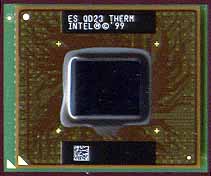Intel Mobile CPU & Chipset Roadmap - November 2000
by Matthew Witheiler on November 23, 2000 6:31 PM EST- Posted in
- CPUs
An old dog: The Coppermine mobile Pentium III
From what we have seen, it will be quite some time before we can bid adieu to our old friend the Coppermine mobile Pentium III. The Coppermine core remains completely unchanged in the higher speed mobile Pentium IIIs, including the standard 256Kb of cache, the normal 100 MHz front side bus, and Intel's SpeedStep technology.
For those not familiar with SpeedStep, let's take a look behind Intel's method of increasing battery life. Essentially, SpeedStep technology increases battery life by decreasing power consumption when running on battery. Since power consumption is a function of capacitance times frequency times the square of the voltage, there are quite a few way to reduce power on the whole. Obviously the best way to reduce power consumption is to decrease the voltage used by a component, as this is the variable that is squared in the power equation. It was therefore no surprise that Intel choose to reduce processor power by decreasing the processor core voltage.
The downside to the reduction in core voltage is that a reduction in clock frequency is also necessary. This is analogous to overclocking a CPU: the higher the core voltage during an overclock, the higher the frequency that can be reached. By taking these two factors into account, one can see how Intel came up with the idea of SpeedStep technology, which dynamically underclocks the CPU and decreases the core voltage when running on battery. For example, a mobile Pentium III 850 MHz running on AC power gives the CPU the 1.6 volts necessary to run at 850 MHz. Once the cord is pulled and the computer starts running on battery, the 850 MHz CPU dynamically underclocks itself to 700 MHz; a speed which requires .25 volts less or 1.35 volts.
The dynamic clock changes occur by actually using the operating system to help alter the power state. When a change in power source is noted by the operating system, it sends the CPU into a standby mode for a very short period of time. It is in this time window that SpeedStep is able to modify the CPU multiplier as well as the core voltage. The system is then "woken-up" in the new power state and is ready to go.
Interestingly enough, Intel's SpeedStep technology is still no match for AMD's PowerNow solution. As we explained in our PowerNow review:
Instead of constantly running a CPU at its maximum frequency, PowerNow! allows the CPU to dynamically adjust its operating frequency according to the needs of the tasks that the CPU is running. For example, launching an application requires immediate attention of the processor, meaning that the CPU would jump up to a fairly high frequency in order to make sure that the application loaded quickly. However, upon entering the application, the system has to wait for user input, meaning that there's no reason for the CPU to sit there at full power waiting for the user to input commands. So, PowerNow! instructs the CPU to drop in clock speed. Then, as the user begins to use the program, the CPU clock speed varies according to the needs of the application and the tasks that are running.
As we should all know by now, lower clocked processors don't always require that the same amount of voltage be supplied to them as those with higher operating frequencies. It would thus only make sense that as the clock frequency of the processor is varying that its core voltage should vary as well, which is exactly what PowerNow! does.
Strangely left out was any mention of Intel's "Quick Start" technology, which we first covered at this Fall's IDF. The technology, which uses the "hurry-up and get idle" theory, was supposed to compete with AMD's PowerNow! technology, but with Intel not promoting it anywhere, we don't know what to make of it.
With all the work Intel has put into the mobile Coppermine parts, it is no surprise that In the performance segment the mobile Pentium III chip remains top dog all the way up until late second quarter 2001. In fact, the current 850 MHz Coppermine mobile Pentium III should remain king of the mountain through the first quarter of 2001. It is not until April of 2001 do we see the mobile chip that will have many drooling: the 1.0 GHz Coppermine mobile Pentium III. This chip will be released along with a 900 MHz part, however this appears to be the end of the line for the Coppermine parts. And with it's death, comes a new kid on the block.











0 Comments
View All Comments